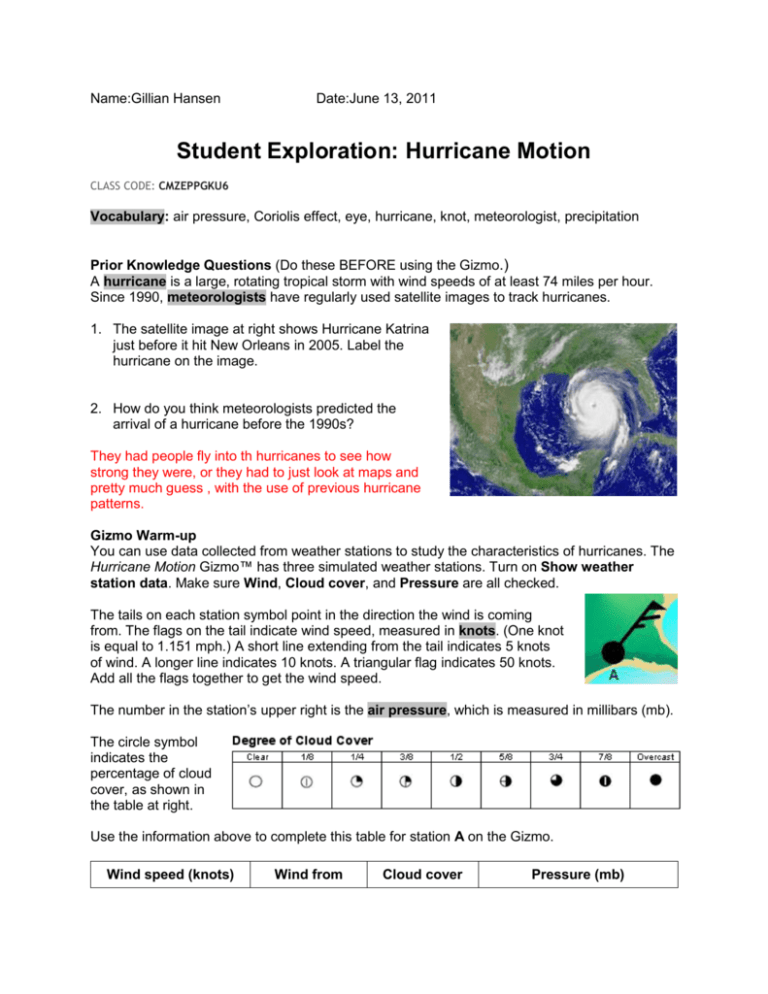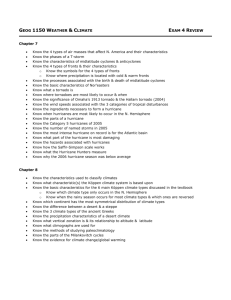gillian hurricane
advertisement

Name:Gillian Hansen Date:June 13, 2011 Student Exploration: Hurricane Motion CLASS CODE: CMZEPPGKU6 Vocabulary: air pressure, Coriolis effect, eye, hurricane, knot, meteorologist, precipitation Prior Knowledge Questions (Do these BEFORE using the Gizmo.) A hurricane is a large, rotating tropical storm with wind speeds of at least 74 miles per hour. Since 1990, meteorologists have regularly used satellite images to track hurricanes. 1. The satellite image at right shows Hurricane Katrina just before it hit New Orleans in 2005. Label the hurricane on the image. 2. How do you think meteorologists predicted the arrival of a hurricane before the 1990s? They had people fly into th hurricanes to see how strong they were, or they had to just look at maps and pretty much guess , with the use of previous hurricane patterns. Gizmo Warm-up You can use data collected from weather stations to study the characteristics of hurricanes. The Hurricane Motion Gizmo™ has three simulated weather stations. Turn on Show weather station data. Make sure Wind, Cloud cover, and Pressure are all checked. The tails on each station symbol point in the direction the wind is coming from. The flags on the tail indicate wind speed, measured in knots. (One knot is equal to 1.151 mph.) A short line extending from the tail indicates 5 knots of wind. A longer line indicates 10 knots. A triangular flag indicates 50 knots. Add all the flags together to get the wind speed. The number in the station’s upper right is the air pressure, which is measured in millibars (mb). The circle symbol indicates the percentage of cloud cover, as shown in the table at right. Use the information above to complete this table for station A on the Gizmo. Wind speed (knots) Wind from Cloud cover Pressure (mb) Activity A: Hurricane characteristics Get the Gizmo ready: Make sure Practice, Show hurricane, and Show weather station data are selected. Introduction: Hurricanes form when an area of low pressure forms over warm water. Wind blows toward the low pressure, but are deflected by Earth’s rotation. The Coriolis effect causes winds to curve to the right in the Northern Hemisphere and to the left in the Southern Hemisphere. This results in a counterclockwise rotation for Northern Hemisphere hurricanes and a clockwise rotation for Southern Hemisphere hurricanes. Question: What are some characteristics of hurricanes? 1. Observe: In which hemisphere is the hurricane shown on the Gizmo? Northern How do you known? Because it is turning right.___________________________ 2. Describe patterns: Under Show hurricane, make sure Radar is selected. Radar is used to determine where precipitation, such as rain, is falling. Blue indicates light rainfall. Heavier rain is shown with yellow and then orange. Red indicates the heaviest rainfall. A. Where within the hurricane is the lightest rainfall?_The outside of the hurricane B. Where within the hurricane is the heaviest rainfall? __The middle of the hurricane C. Describe any patterns you see in the distribution of a hurricane’s rain. ____________ _____The rain is heaviest on the inside of the hurricane and lightest on the outside of the hurricane_ 3. Observe: Under Show hurricane, select Satellite. Satellite images are taken from cameras built into satellites orbiting Earth. These images are used to study cloud coverage over large areas, including the clouds associated with a hurricane. A. Which is larger, the area of rainfall or the area of cloud cover? Area of rainfall B. Where is the cloud cover most dense? Closer to the middle of the hurricane but not in the eye. C. Where is the cloud cover least dense? ____On the outside of the hurricane 4. Identify: The center of rotation of a hurricane is called the eye. The eye of a hurricane is a core of warm, relatively calm air with low pressure and light winds. Label the eye on the hurricane at right. (Activity A continued on next page) Activity A (continued from previous page) 5. Classify: Hurricanes are categorized based on their wind speeds. The chart at right shows the five categories used to classify hurricanes. Category Wind speed (mph) 1 74-95 mph 2 96-110 mph 3 111-130 mph 4 131-155 mph 5 greater than 155 mph Move the hurricane so that the center of the storm is directly over one of the weather stations. A. Remember one knot is equal to 1.151 miles per hour. What is the hurricane’s highest wind speed in miles per hour? ___greater thenn 155___ B. What category is this hurricane? ___5____ 6. Observe: Move the hurricane towards another weather station. As you do this, observe the cloud cover, wind speed, and air pressure at the station. A. How does the cloud cover change? ___The cloud cover is full B. How does the wind speed change? ______It goes up______ C. How does the air pressure change? ____It goes down_ 7. Collect data: Move a hurricane north, east, south, and west of a weather station. In the table below, record the wind direction in each case. Hurricane position in relation to weather station Wind direction at weather station North west East north South east West south 8. Analyze: How can you tell the location of the hurricane relative to a weather station based on this information? ___You know by which way the wind is coming from it the wind is coming from the north the hurricane is coming from the west. The way the wind blows can tell you where the hurricane is coming from. Activity B: Get the Gizmo ready: Predict hurricanes Select Experiment and click Pause ( ). Question: How can you predict the location and path of a hurricane? 1. Observe: Click Play ( ), and wait until you see a hurricane approaching one of the weather stations. Click Pause. What changes indicate a hurricane is approaching? Cloud cover: _____gets a bit clouder Air pressure: ____gets lower Wind speed: ___gets higher______________________ 2. Observe: Click Play, and wait for the hurricane to go over the land. What happens in the hours after landfall? _____the wind gets higher, air pressure lower, lots of rain. 3. Collect data: Click Reset ( ). Turn off Show hurricane. Click Play. When the simulation reads Day 1, 3:00 PM, click Pause and record the data from each weather station. Station Wind speed (knots) Wind from Cloud cover Pressure (mb) A 10 knots north clear 1046.2 B 10 knots North east clear 1042.0 C 25 knots North east coudy 1026.5 4. Interpret: Using the readings above, do you think a hurricane is nearby? Explain. __no because all of the winds are low and it is mostly clear and the pressure isnt too low.__ Run Gizmo: Allow the Gizmo to run until the weather station data indicates a hurricane is nearby and will soon make landfall. Click Pause. A. What weather station data indicated a hurricane would soon make landfall? __weather station c___ B. Turn on Show hurricane. Was your prediction correct? Explain. _yes because the pressure was low at weather station c and the wind was picking up, also it was cloudier so I thought there was a good shoot that it was going to land there.______________ ___________________________________________________________________ (Activity B continued on next page) Activity B (continued from previous page) 5. Gather data: Turn off Show hurricane, and click Reset. Click Play. At 12:00 P.M. of day 1, click Pause. Drag a pointer to the predicted position of the eye of the hurricane, and draw an arrow in the diagram below. Label this arrow “1.” Turn on Show hurricane, and mark a circle where the actual eye is located. Label this circle “1.” Turn off Show hurricane, and then repeat this procedure every 12 hours to mark the predicted and actual path of the hurricane. 6. On your own: Practice predicting the current and future positions of hurricanes. You can click the POINTER button at the bottom of the Gizmo and drag an arrow to where you think the eye of the hurricane is located. Turn on Show hurricane to check your prediction. Click COPY SCREEN to take a snapshot of the predicted and actual positions of the hurricane. Paste your snapshots into a black document. Label each snapshot. Turn in your hurricane tracking document with this worksheet. 7. Make connections: As warm, moist air rises, water vapor in the air condenses and releases a great deal of heat energy. This energy powers a hurricane. How does this information explain what happens to the hurricanes after they make landfall? ________________Well the ground if it is cold doesn’t help the hurricane but if t is warm the hurricane will stay for longer in that area. That is why certain places get hurricanes a lot more often than others.





